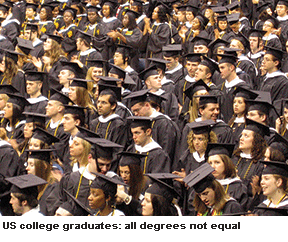 WHEN LATISHA Styles graduated from Kennesaw State University in Georgia in 2006, she had $35,000 (Rs.21 lakh) of student debt. This obligation would have been easy to discharge if her Spanish degree had helped her land a well-paid job. But there is no dearth of Spanish speakers in a nation that borders Latin America. So Styles found herself working in an apparel shop and a fast-food restaurant for no more than $11 per hour.
WHEN LATISHA Styles graduated from Kennesaw State University in Georgia in 2006, she had $35,000 (Rs.21 lakh) of student debt. This obligation would have been easy to discharge if her Spanish degree had helped her land a well-paid job. But there is no dearth of Spanish speakers in a nation that borders Latin America. So Styles found herself working in an apparel shop and a fast-food restaurant for no more than $11 per hour.
Frustrated, she took the gutsy decision to revisit the same college and enroll in something more pragmatic. She majored in finance, and now has a good job at an investment consulting firm. Her debt has swollen to $65,000, but she expects little trouble paying it off.
As Styles’ story shows there’s no simple answer to the question “Is college worth it?” Some degrees pay for themselves; others don’t. American school leavers pondering whether to take on huge student loans are constantly told that college is the gateway to the middle class. The truth is more nuanced, as Barack Obama hinted when he said in January that “folks can make a lot more” by learning a trade “than they might with an art history degree”. An angry art history professor forced him to apologise, but he was right.
College graduates aged 25-32 who are working full-time earn about $17,500 (Rs.10 lakh) more annually than their peers who have only a high school diploma, according to the Pew Research Centre, a think-tank. But not all degrees are equally useful. And given how much they cost — a residential four-year degree programme can set you back as much as $60,000 (Rs.36 lakh) a year — many students end up worse off than if they had started working at 18.
PayScale, a research firm, has gathered data on graduates of more than 900 universities and colleges in the US, asking them what they studied and how much they now earn. The company then factors in the cost of a degree, after financial aid (discounts for the clever or impecunious that greatly reduce the sticker price at many universities). From this, PayScale estimates the financial returns of different types of degree.
Unsurprisingly, engineering is a good bet wherever you study it. An engineering graduate of the University of California, Berkeley can expect to be nearly $1.1 million (Rs.6.5 crore) better off after 20 years than someone who never went to college. Even the least lucrative engineering courses generated a 20-year return of almost $500,000 (Rs.2.9 crore).
Arts and humanities courses are much more varied. All doubtless nourish the soul, but not all fatten the wallet. An arts degree from a rigorous school such as Columbia or the University of California, San Diego, pays off handsomely. But an arts graduate from Murray State University in Kentucky can expect to make $147,000 (Rs.87 lakh) less over 20 years than a high school graduate, after paying for his education. Of the 153 arts degrees in the study, 46 generated a return on investment worse than plonking the money in 20-year treasury bills. Of those, 18 offered returns worse than zero.
What’s not in doubt is that the price of university per student has risen by almost five times the rate of inflation since 1983, while graduate salaries have been flat for much of the past decade. Student debt has grown so large that it stops many young people from buying houses, starting businesses or having children. Those who borrowed for a bachelor’s degree granted in 2012 owe an average of $29,400 (Rs.17 lakh). The Project on Student Debt, a non-profit, says 15 percent of borrowers default within three years of entering repayment. At for-profit colleges, the rate is 22 percent. Glenn Reynolds, a law professor and author of The Higher Education Bubble, writes of graduates who “may wind up living in their parents’ basements until they are old enough to collect social security”.
(Excerpted and adapted from The Economist)